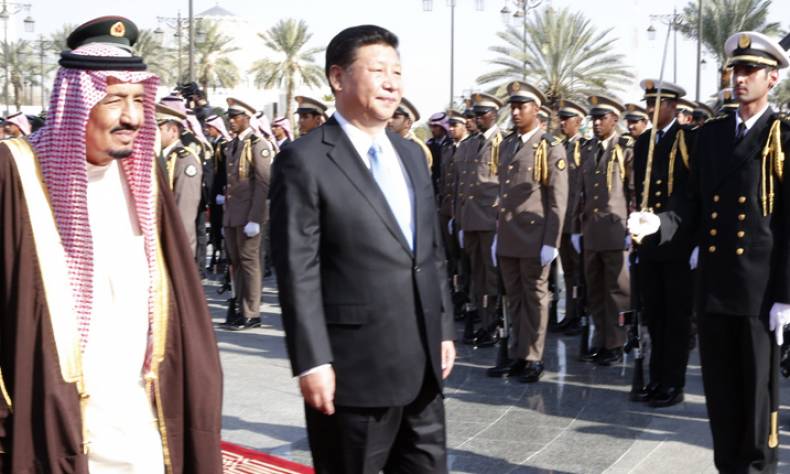
Chinese President Xi Jinping to Charm Middle East with Belt and Road Plan
Chinese President Xi Jinping is welcomed in Riyadh by King Salman of Saudi Arabia as he begins his three-country tour of the Middle East on Jan. 19.
Chinese President Xi Jinping arrived today in Saudi Arabia as he kicks off what Xinhua News Agency is already hailing as an opportunity for China to visit “long-time good friends” while emphasizing stability and development through constructive engagement. Wow. That is quite the picture painted, of buddies sitting around over strong Arabic coffee and reminiscing about the good old days. Sounds fun.
President Xi is set to make a speech on China’s policy towards the Middle East while in Egypt, a platform where catch-all phrases such as “win-win cooperation” (actually, the China Daily piece uses “pragmatic cooperation, but close enough) will undoubtedly be trotted out. But the purpose of the visit is two-fold for China: first off, it is primarily symbolic, signaling China’s need to get involved in a part of the world that has been to date dominated by the U.S. and Russia, at least in the media; and second, it is all about economics.
After Saudi Arabia, President Xi will visit Egypt then Iran (in that order presumably, but the trip is apparently something of a secret, with the exact dates for each country unknown). The key item on the agenda will be China’s massive infrastructure plans for the region in the coming years. To be fair, China and the Middle East do have a long and storied history that can be traced back more than two thousand years, although those were different times with very different systems of governance in charge.
For those that have a high tolerance for dry government speak, here is China’s Arab Policy Paper, released via the Ministry of Foreign Affairs on Jan. 13. Looking past all the platitudes common in such reports, the promises of “win-win results” and all the goodies that fall under the Beijing Consensus (a.k.a. the Chinese Economic Model), then we can get to the real meat and potatoes of the policy paper.
First up is the promise of greater political cooperation. This is simple enough and mainly promises increased dialogue between China and the various governments. There is a particularly timely sub-section though that deals with the Taiwan issue, with sub-section 1.5 stating that “The one China principle is the important basis for China to establish and develop relations with Arab states and regional organizations.” Again, pretty timely given the recent elections in Taiwan.
Then there is the heart of the policy paper, and as such, the whole purpose for the trip: investment and trade cooperation. And the first sub-section under investment and trade? The much-ballyhooed “Belt and Road” initiative.
China’s foreign policy has always favored development through infrastructure and trade, which is what will be mostly discussed throughout Xi’s visits. Just take the African blueprint and update it for the Middle East. As mentioned earlier, the Middle East is a key region in China’s hugely important Belt and Road plan for the future, and so stability in the region is paramount. But how? Stability through development? Maybe, but if the region is going to destabilize, it is unlikely that Chinese-backed development is going to make much of difference.
And while China has pledged neutrality with regards to geopolitics—it is already the biggest trade partner for all three countries—it’s likelier than not that China will tend to favor relations with Iran, given Saudi Arabia’s traditionally close relationship with the U.S. China has had almost unparalleled access to Iranian trade since the sanctions were imposed, first in 1979 by the U.S. and then in 2006 by the UN, but now will have to compete with global (primarily Western) interests as the sanctions are lifted. That is where the Belt and Road initiative comes into play as China seeks to preserve its dominant position in Iran.
China will almost certainly look to secure more oil imports from Iran as it reduces its dependence on Saudi oil, but it also cannot risk upsetting the Saudis in fear of showing favoritism to its key regional rival.
As Chinese Vice Foreign Minister Zhang Ming told reporters on Jan. 18, China will not be taking sides. Seems a pretty pragmatic way to inch a leg in the door instead of just a foot.
There will be other aspects discussed, such as terrorism—a major part of the regional stability that China (and the world) covets—but for now the primary talking points that President Xi will cover will be the economic benefits to be gleaned from the Belt and Road initiative, with energy one of the main sectors discussed, and the advancement of regular dialogue between China and the Middle East’s most influential governments.
[UPDATE – President Xi met with Secretary-General Abdul Latif bin Rashid Al Zayani of the Cooperation Council for the Arab States of the Gulf (GCC) today to discuss energy deals, a pending free-trade agreement, and other areas for trade that include infrastructure, telecommunications, aerospace, and renewable energy.]
 Facebook
Facebook
 Twitter
Twitter
 Linkedin
Linkedin
 Google +
Google +











